Isabella Fischer's Blog: The Mdantsane Way, page 2
August 9, 2013
A Rare Recording Of The Xhosa Sacred Singers - Ndiyakolwa on 78rpm Gallotone
Before we continue with the second part of our "Hugh Tracey And The International Library Of African Music" story, we bring you another rare recording of "The Xhosa Sacred Singers" - Ndiyakolwa produced and pressed on the Gallo label.
Here it is played on a President travel gramophone.
http://feeds.feedburner.com/blogspot/...
Here it is played on a President travel gramophone.
http://feeds.feedburner.com/blogspot/...

Published on August 09, 2013 00:51
August 6, 2013
Mdantsane Cribs - Cool Modern Retro Properties
Townships in South Africa are generally associated with poverty, low cost housing or make-do housing, meaning shacks. The expression "Shanty Town" is used for informal settlements and impoverished living areas.
A shanty town also called a squatter settlement is a slum settlement, sometimes illegal or unauthorized, where the houses are made of plywood, corrugated iron,
sheets of plastic, and cardboard boxes. Shanty towns, which are usually
built on the periphery of cities, often do not have proper sanitation,
water supply or aqueduct, electricity or telephone services.
And nobody who owns a little bit, has a little bit and still yearns for a little bit more in life, than he or she has right now, wants to live next to a "Shanty Town" in South Africa.
When buying a property in South Africa buyers are strongly influenced by the future development potential of the area surrounding the property like everywhere else, but here in South Africa special attention is paid to the possibility, that existing townships and informal settlements in the area might spread out and shanty towns might develop in the vicinity of the property on sale.
If this possibility exists the property in question is much more difficult to sell and looses market value.
The preconceived idea of a shanty town is not a good one!
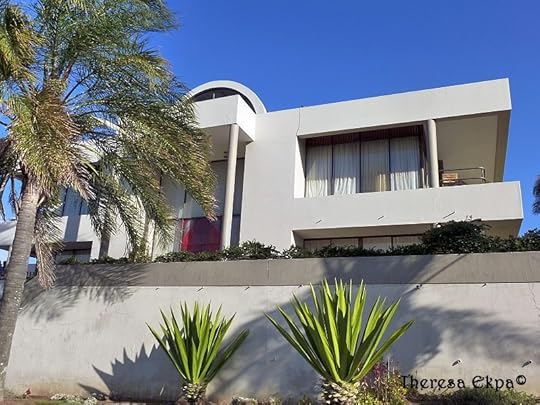
A cool modern retro crib in Mdantsane
Shanty towns are mostly found in developing nations, or partially developed nations with unequal distribution of wealth. In extreme cases, shanty towns have populations approaching millions. According to the Wikipedia as of 2005, one billion people, one-seventh of the world's population, live in shanty towns.
This might be true but as always there is the other side of the medallion. And until you turn the medallion around you don't see it.
In Mdantsane you can find amazing modern upmarket houses, that the outside spectator would never associate with the classical, traditional definition of a township house.
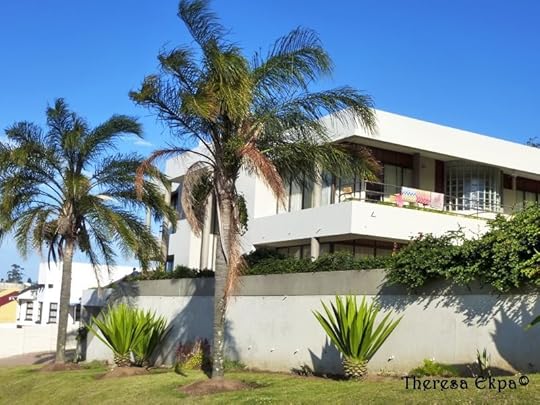
NO more Shanty Town - An upmarket property in Mdanstane
The suburbs NU 9 and NU 17 in Mdantsane are the home of stylish modern luxury cribs like the mansion in the pictures, that is build in a modern retro style. The architecture of this double storey building incorporates a lot of glass and steel elements.
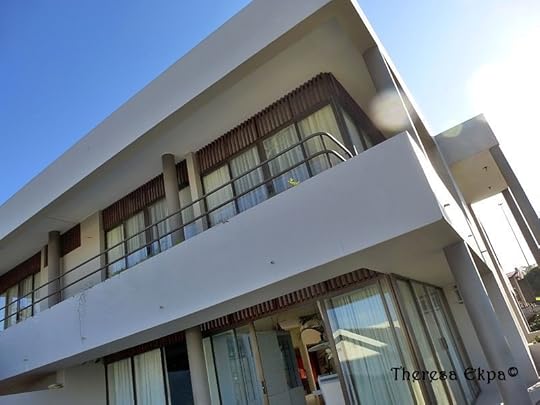
A double storey upmarket property in Mdantsane
We have been working on a couple of articles, which we would like to develop into an ongoing series "Mdantsane Cribs". We feel honored, that we have been invited by many families into their home and that they have shared their intimate living space and a meal with us for a couple of hours. This has given us an idea how beautiful, creative and diverse the Mdantsane homes are on the inside.
How much HOME they are!
No matter if the home we visited, was a shack, a middle class house or a small palace like the one in the images - we have seen amazing interiors, that have left us speechless. Fascination lies in the creativity used to create beauty and how much you make out of something.

Mdantsane Property With A Malibu Setting
The following facts might also surprise you. Houses in NU 17 fully fenced with three bedrooms, two bathrooms, one lounge and kitchen fetch up to 550.000 Rand at present. These are normal houses, that are not the embodiment of luxury and extravagance. Just simple normal houses - like this one.

Property on Sale by Xoliswa Tini Properties in NU 17 in Mdantsane for 550.000 Rand
Xoliswa Tini Properties is another South African success story. Xoliswa Tini was one of the first black ladies to enter the property market in East London and to turn her business into a financial success. She was one of the first property agents to market the Mdantsane properties. Xoliswa Tini Properties just celebrated 10 years in business in June 2013.
Xoliswa said that it has not all been plain sailing during the past 10
years but she describes her business with the following metaphor : "We are like that
little duck on the water. In sight is a calm duck swimming but unseen
under the water the duck is paddling away."

Palm Trees Holding The Sun A Captive
Back to the modern retro crib of our today's article. The inside is as stylish as the outside.
A predominantly white interior with some furniture pieces in the accents colors mint green and burned orange is soothing and calming to the eye. No furniture overload here.
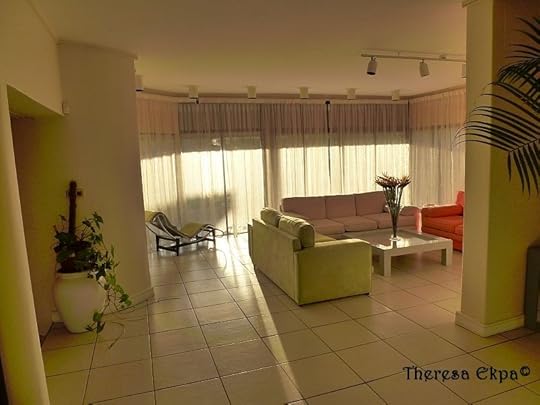
Contemporary interior design in an upmarket house in Mdantsane
Clean simple lines and open plan living dominate.
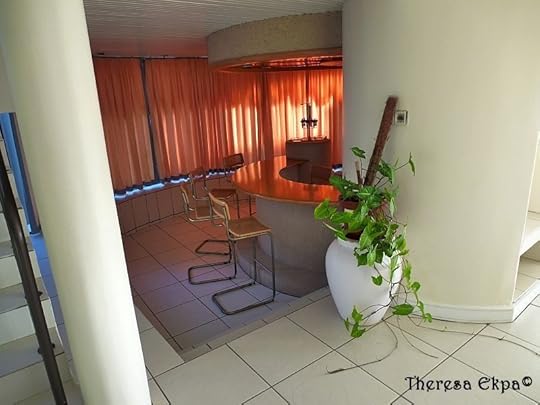
The bar area like the whole house has a retro feel.
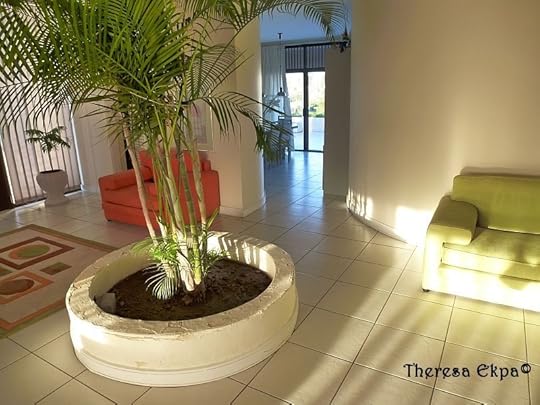
Palm tree integrated into the foyer
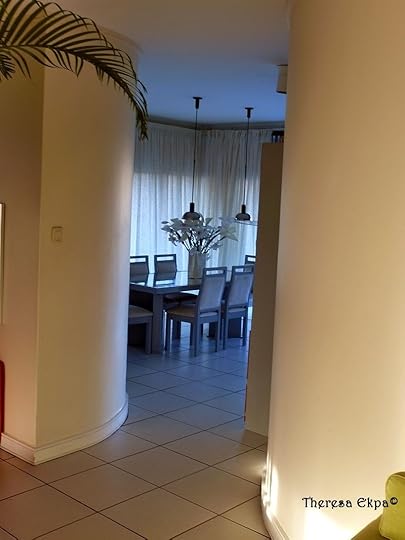
The Dining Room Area tucked away between pillars
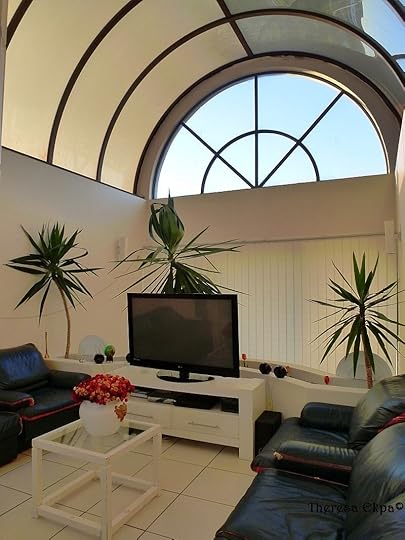
The TV lounge, black leather and white again
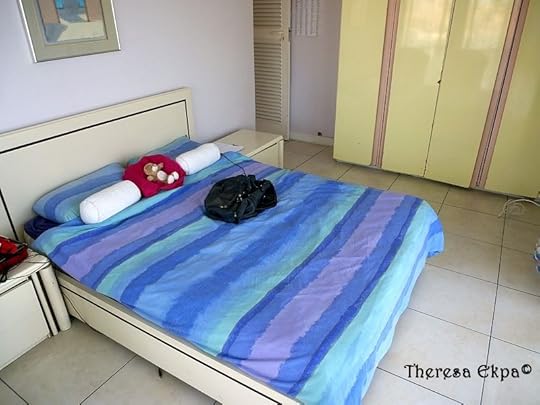
A Guest Room
And of course houses like this need maintenance and one employee will simply not do if do not want to clean and swipe the whole day!
http://feeds.feedburner.com/blogspot/...
A shanty town also called a squatter settlement is a slum settlement, sometimes illegal or unauthorized, where the houses are made of plywood, corrugated iron,
sheets of plastic, and cardboard boxes. Shanty towns, which are usually
built on the periphery of cities, often do not have proper sanitation,
water supply or aqueduct, electricity or telephone services.
And nobody who owns a little bit, has a little bit and still yearns for a little bit more in life, than he or she has right now, wants to live next to a "Shanty Town" in South Africa.
When buying a property in South Africa buyers are strongly influenced by the future development potential of the area surrounding the property like everywhere else, but here in South Africa special attention is paid to the possibility, that existing townships and informal settlements in the area might spread out and shanty towns might develop in the vicinity of the property on sale.
If this possibility exists the property in question is much more difficult to sell and looses market value.
The preconceived idea of a shanty town is not a good one!

A cool modern retro crib in Mdantsane
Shanty towns are mostly found in developing nations, or partially developed nations with unequal distribution of wealth. In extreme cases, shanty towns have populations approaching millions. According to the Wikipedia as of 2005, one billion people, one-seventh of the world's population, live in shanty towns.
This might be true but as always there is the other side of the medallion. And until you turn the medallion around you don't see it.
In Mdantsane you can find amazing modern upmarket houses, that the outside spectator would never associate with the classical, traditional definition of a township house.

NO more Shanty Town - An upmarket property in Mdanstane
The suburbs NU 9 and NU 17 in Mdantsane are the home of stylish modern luxury cribs like the mansion in the pictures, that is build in a modern retro style. The architecture of this double storey building incorporates a lot of glass and steel elements.

A double storey upmarket property in Mdantsane
We have been working on a couple of articles, which we would like to develop into an ongoing series "Mdantsane Cribs". We feel honored, that we have been invited by many families into their home and that they have shared their intimate living space and a meal with us for a couple of hours. This has given us an idea how beautiful, creative and diverse the Mdantsane homes are on the inside.
How much HOME they are!
No matter if the home we visited, was a shack, a middle class house or a small palace like the one in the images - we have seen amazing interiors, that have left us speechless. Fascination lies in the creativity used to create beauty and how much you make out of something.

Mdantsane Property With A Malibu Setting
The following facts might also surprise you. Houses in NU 17 fully fenced with three bedrooms, two bathrooms, one lounge and kitchen fetch up to 550.000 Rand at present. These are normal houses, that are not the embodiment of luxury and extravagance. Just simple normal houses - like this one.

Property on Sale by Xoliswa Tini Properties in NU 17 in Mdantsane for 550.000 Rand
Xoliswa Tini Properties is another South African success story. Xoliswa Tini was one of the first black ladies to enter the property market in East London and to turn her business into a financial success. She was one of the first property agents to market the Mdantsane properties. Xoliswa Tini Properties just celebrated 10 years in business in June 2013.
Xoliswa said that it has not all been plain sailing during the past 10
years but she describes her business with the following metaphor : "We are like that
little duck on the water. In sight is a calm duck swimming but unseen
under the water the duck is paddling away."

Palm Trees Holding The Sun A Captive
Back to the modern retro crib of our today's article. The inside is as stylish as the outside.
A predominantly white interior with some furniture pieces in the accents colors mint green and burned orange is soothing and calming to the eye. No furniture overload here.

Contemporary interior design in an upmarket house in Mdantsane
Clean simple lines and open plan living dominate.

The bar area like the whole house has a retro feel.

Palm tree integrated into the foyer

The Dining Room Area tucked away between pillars

The TV lounge, black leather and white again

A Guest Room
And of course houses like this need maintenance and one employee will simply not do if do not want to clean and swipe the whole day!
http://feeds.feedburner.com/blogspot/...

Published on August 06, 2013 01:21
July 31, 2013
Rally For The Mdantsane Way Magazine - Looking For Our First Supporter
We are looking for our first supporter in this rally
We are trying to raise funds for our township magazine "The Mdantsane Way" . We have received dozens of
applications from young journalism graduates who have just left
university and would like to get an internship with us. Most of them come from Mdantsane, the place where they are born grew up and that they love dearly.
The budget we are trying to raise will allow us to recruit
and mentor young South Africans for a period of two years. Many of them
would be happy with just an intership which would allow them to start their career as journalists.
South Africa has an unemployment rate of 25% and if we achieve the goal we have set for us we will be able to give young graduates a chance and keep them away from the streest and from crime. Additionally young people from Mdantsane will get a chance to write about their township and share their stories withe world.
Now we are looking for our very first donor who
would be willing to start this campaign with us. Have a look at our Rally page https://rally.org/themdantsanewaymagazine
You can donate here:
http://feeds.feedburner.com/blogspot/...
We are trying to raise funds for our township magazine "The Mdantsane Way" . We have received dozens of
applications from young journalism graduates who have just left
university and would like to get an internship with us. Most of them come from Mdantsane, the place where they are born grew up and that they love dearly.
The budget we are trying to raise will allow us to recruit
and mentor young South Africans for a period of two years. Many of them
would be happy with just an intership which would allow them to start their career as journalists.
South Africa has an unemployment rate of 25% and if we achieve the goal we have set for us we will be able to give young graduates a chance and keep them away from the streest and from crime. Additionally young people from Mdantsane will get a chance to write about their township and share their stories withe world.
Now we are looking for our very first donor who
would be willing to start this campaign with us. Have a look at our Rally page https://rally.org/themdantsanewaymagazine
You can donate here:
http://feeds.feedburner.com/blogspot/...

Published on July 31, 2013 00:01
July 30, 2013
Hugh Tracey And The International Library Of AFRICAN MUSIC - For Future Generations
We have called Hugh Tracey legendary. And his legend will grow in the decades to come.
Hugh Tracey is the guardian of African music, a man who dedicated his entire life to the preservation, promotion and documentation of traditional African music for later generations. He did that at a time, when nobody else thought of it.
Hugh Tracey had such an exciting and fulfilled life, that just a couple of sentences will simply not do. To give you an idea who this man was and how he became this impressive figure known by African music lovers, we are looking at his early years from 1921 to 1947 today.
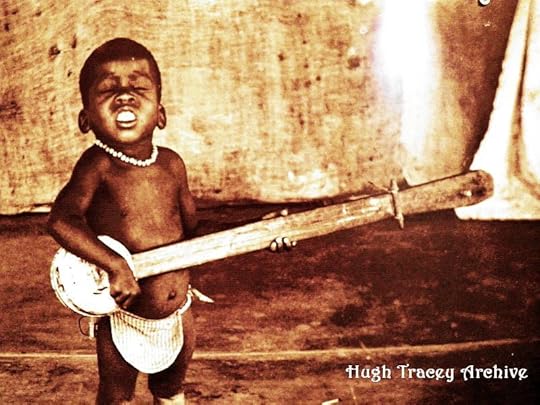
Hugh Tracey became The Guardian Of African Music. His images and his recordings of indigenous African music have been one of the first in Southern Africa
Hugh Tracey arrived in 1921 at the age of 18 in what was then called Southern Rhodesia (Zimbabwe) from Devonshire in England.
This young man had come to work on his brother's tobacco plantation in the Gutu district, near Chivu. He came like many other white people to make a living and to find a new life in colonial Africa. But soon his interest and passion in African music lead him on an entirely different path.
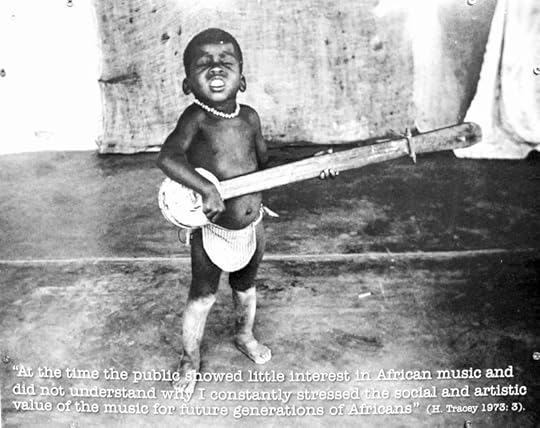
Hugh Tracey's Recordings Of African Music are Amongst The First That Had Been Done On The African Continent
As early as 1929 Hugh Tracey took 14 young Karanga musicians 500 km South to Johannesburg to be recorded by Columbia, London.
These are the first recordings of Karanga music ever to be published!
Soon after that several of these recordings were played as opening music at the historic first concert of African American musicians at the Carnegie Hall in NYC.
Five of the original 16 recorded items remain in the ILAM archive (International Library Of African Music) of which Hugh Tracey became later the founder.
In 1931 Hugh was awarded a Carnegie fellowship grant to study the "indigenous music of Southern Rhodesia". From 1932 to July 1933 he recorded over 600 items in the field on plain aluminium discs with an early model of reporting gear.
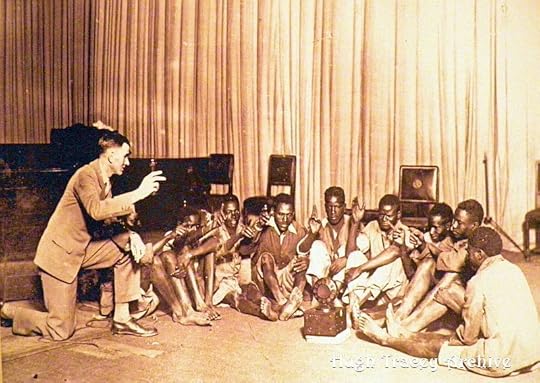
Hugh Tracey recording Karanga musicians in a Cape Town studio in March 1933
In 1933 he traveled by train to Cape Town with 16 Karanga musicians to take advantage of a temporary visit of a team of professional recording engineers.
In 1934/35 Hugh Tracey began a professional broad casting career at the SABC in Cape Town.
From 1936 to 1947 he was the director of the SABC radio in Durban.

Hugh Tracey is the founder of ILAM - International Library Of African Music
Hugh tracey was never too shy to use his own money for what he was passionate about.
In 1940 Hugh Tracey started out on a self funded trip to discover Chopi Timbila Xylophone orchestras in Mozambique. He was so impressed with the size of the orchestras and dance troupes and the sophistication of the music, that he brought a group of six timbila players to Durban by boat to make quality recordings of their music.
He studied thoroughly the compositional and playing techniques of Chopi music, its instrument technology and its musical form in order to write his by now famous and very much respected book "Chopi Musicians" which was published in 1948 in the Portuguese language.
Hugh was fluent in Portueguese. "Chopi Musicians" was also published in English by the Oxford Press.
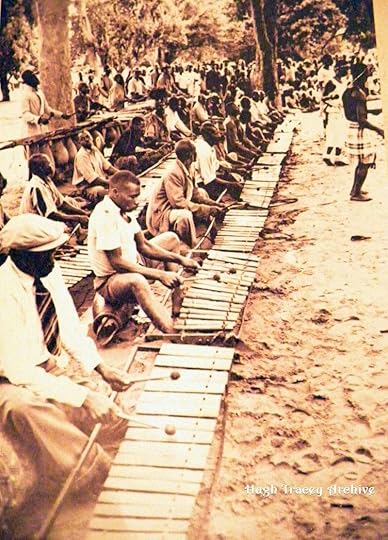
A Chopi Timbila Orchestra consisting of hundreds of players in Mozambique - Image by Hugh Tracey
The field trips that Hugh Tracey conducted were rather unusual for the time.
First of all, because generally the interest in indigenous African music amongst white people in Africa specifically and in the world was very low at the beginning of the 20 th. century. Why record African music? Who would listen to it?
African indigenous music was considered as simple, repetitive and disharmonious by many at a time when Victor Silvester And His Ballroom Orchestra rocked the world with his slow fox trots and quicksteps. A distinct contrast.
Secondly these recordings were not easy to do.
Indigenous African music was played were the people lived, in the villages of Africa, on the fields and in their homes. To record their music you had to come in close contact with them and being allowed to participate in their ceremonies and their rituals. Speak their language and overcome suspicion.
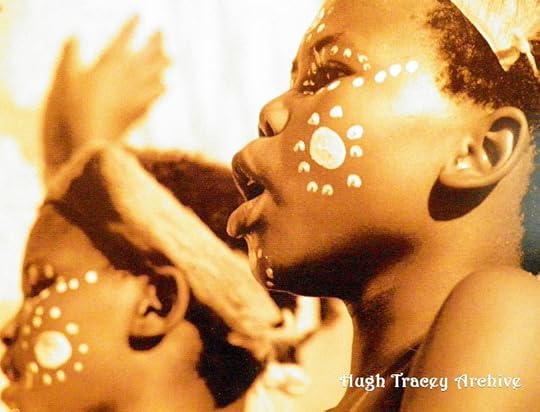
"Their Words Are Never Meant For The Ears Of Outsiders", Hugh Tracey
In 1948 Hugh Tracey wrote:
"The Songs of Africa only composed for the delectation the village, the district, or at most, the tribe are a kind of aural portraiture. They reveal African thought and character more clearly than other means....for discovering what they think and feel, what they consider important in their social and political life, their humour desires, regrets and despair. They are expressed in words never meant for the ears of outsiders."
(from his book Lalela Zulu - 100 Zulu lyrics).

A Chopi Player
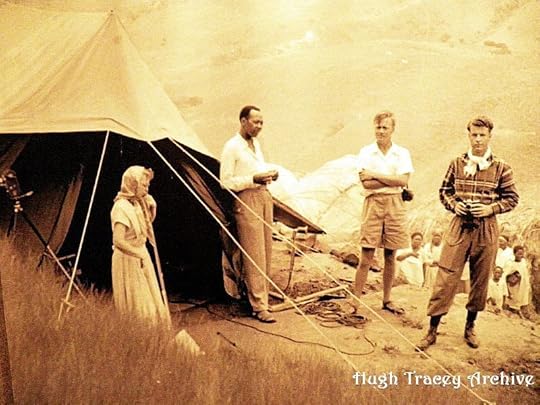
Hugh Tracey On A Field Trip
Hugh Tracey's team had to travel to remote areas with recording equipment, that is exhibited in museums today.
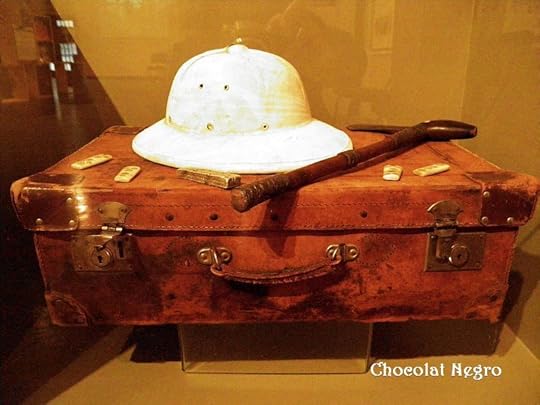
The unavoidable colonial outfit of the time

Recording equipment similar to the one Hugh Tracey used

A stop watch used in recording
Hugh Tracey's typical field expedition from 1948 onwards consisted of three vehicles: a recording van, (with EMI, Lyrec and other lathes and recorders), a truck with a 220 Volt diesel generator trailer, and a caravan.
He had a minimum crew of four or more, including a sound engineer and two driver/field assistants Sam Shabalala and Daniel Mabuto.
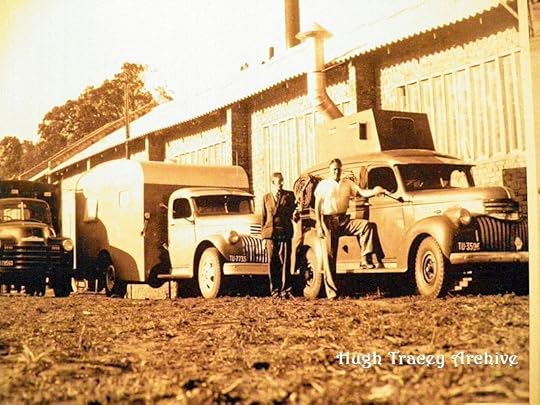
His typical field expedition from 1948 onwards made use of three vehicles
Recording in the field throughout the Sub-Saharan Africa wherever the music was being performed was not a simple task. Tracey had to invent a specially costumized roof raised high enough so his recording engineer could stand in the recording van, and had to have an engine strong enough to pull a generator that weighed half a ton to provide the electricity required for recording.
The noisy generator had to be set up out of ear shot; this meant a long electrical cable had to be run from the generator to the truck where the sound engineer controlled the recording equipment.
Tracey;s recording technique was to always hold the microphone in his right hand, and his stopwatch in his left hand. With the microphone on a short boom he moved around among the musicians following the sounds to capture the essence of each performance with a good sound balance and thereby produce field recordings of exceptional quality.
As technology shrank so did the team. His last recordings of Princes Constance Magogo were made with no assistance with a battery powered Nagra III tape recorder.
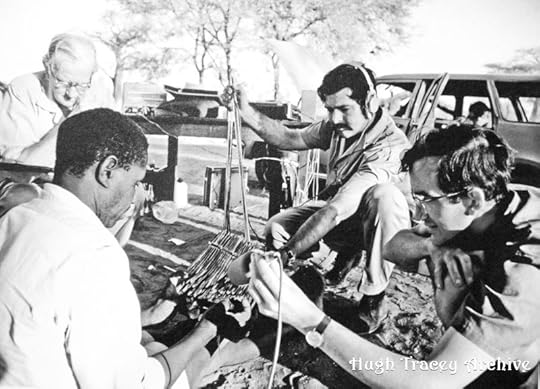
Hugh Tracey At Work
And in the end: he shook black people's hands - this was not done at the time.
"He was one of the few white people in Johannesburg who would shake a black man's hand as a natural thing to do". (David Coplan).
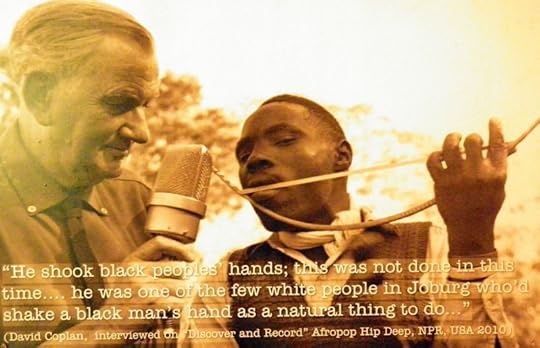
Hugh Tracey Recording
Hugh continued to research Chopi music throughout his life and career and he produced two films on timbila xylophone construction techniques Chopi Music Parts 1 and 2 in 1955.
His son Andrew followed in his footsteps and extended his own research on Chopi Music to the nyanga panpipe tradition.

Hugh Tracey had a deep passion and fascination for Chopi music and in 1948 he published his book "Chopi Musicians, Their Music, Instruments And Poetry" in Portuguese And English
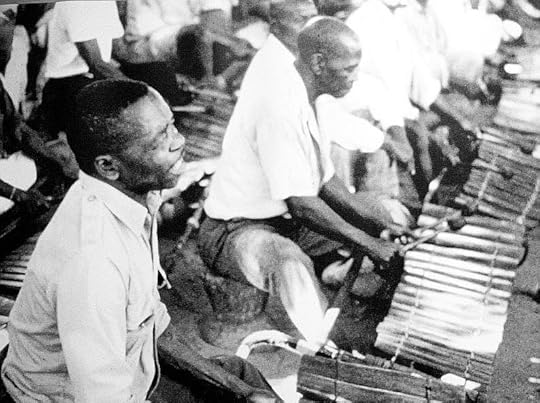
He produced two films about the construction of timbila xylophone techniques Chopi Music Parts 1 and 2 in 1955
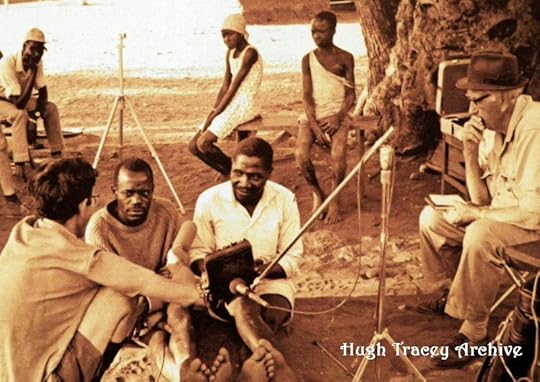
Hugh Tracey and Andrew Tracey recording Hera Mbira players in Mozambique
But Hugh Tracey did not stop there.
Although most of his research took place in Southern Africa he ventured into other African regions with his field trips as far as DRC.
In 1948 he undertook field excursion to Southern Rhodesia (Zimbabwe), Northern Rhodesia (Zambia), Northern Transvaal, Natal and South Africa.
In 1949 field excursions to Mozambique, Southern Congo, Malawi (Nyasaland) Southern Rhodesia and Northern Rhodesia were conducted by him and his team.
The images we have published here originate from some of these trip and are the property of Hugh Tracey.
They have left a deep impression on us because they show the extent and the scope of Hugh Tracey's work and the legacy he has created for his life and left behind for others with the intent to enable them to understand African music.
He was one of the first people of the last century who had a deep understanding of African music.
He understood the value of indigenous African music and it is his recordings we are collecting today and playing for you in our magazine.
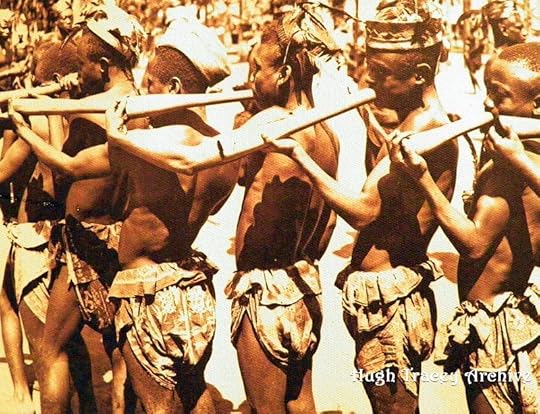
Young men of the Medje Chieftancy, Mekere people playing wooden trumpets in DRC
We know about Hugh's work since a long time but when we discovered the scope and the depth of research during a visit at the small East London museum, that was hosting an exhibition about him and his life's work, we decided that we would dress this content into a story and bring it you, our readers.
Africa is the cradle of mankind and African music is world heritage.
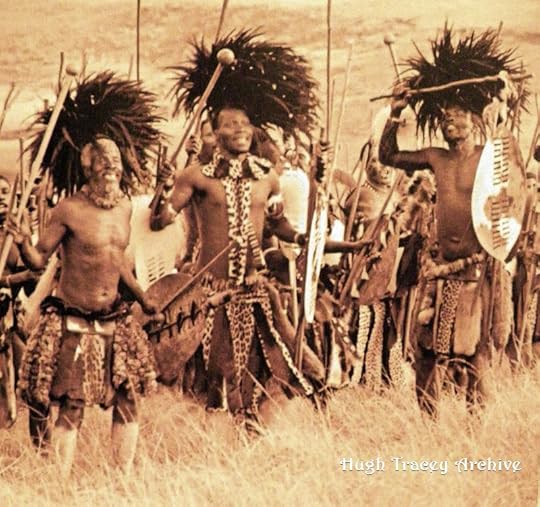
Zulu Chief Mohlutini (Centre) leading the dance near Mahlabatini, KwaZulu Natal
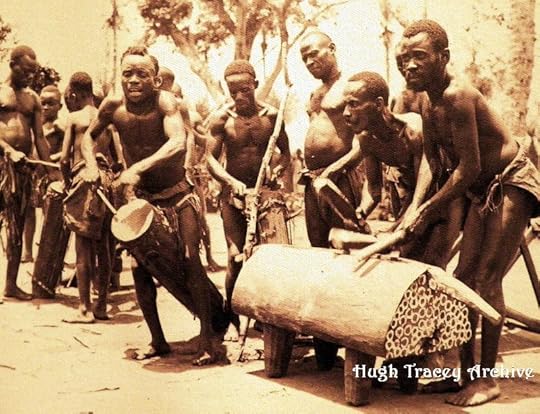
Balele Pygmies playing cylindrical drums and a slit drum
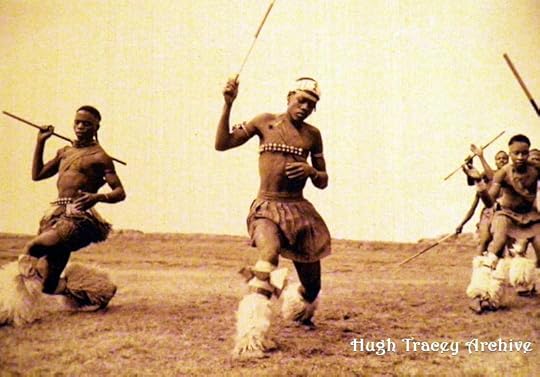
Traditional Dancers In The Witwatersrand Gold Mines
In 1947 the final break through for his work came when with the support of Gallo records owner Eric Gallo he established the African Music Research Unit in Roodeport, as part of Gallo's operations. From 1947 to 1953 Gallo Records pressed several hundred 78rpm shellac records, judged at the time to be the most commercially valuable of Hugh Tracey's recordings.
In 1948 Hugh Tracey established the African Music Society Newsletter which he ran until 1953!
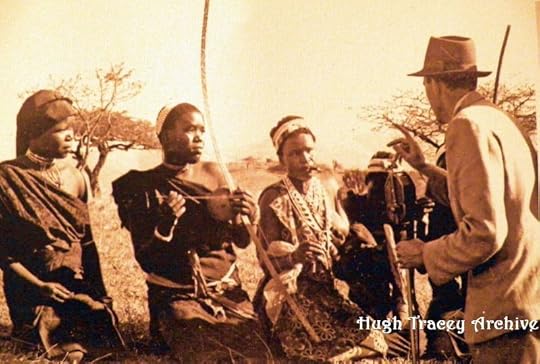
In 1958 Hugh Tracey recorded the famou Zulu bow player Princess Constance Magogo Dinuzulu, the mother of chief Mangosutho Buthelezi.
The 1958 recordings are found on Tracey's LP "Music of Africa" series No.37
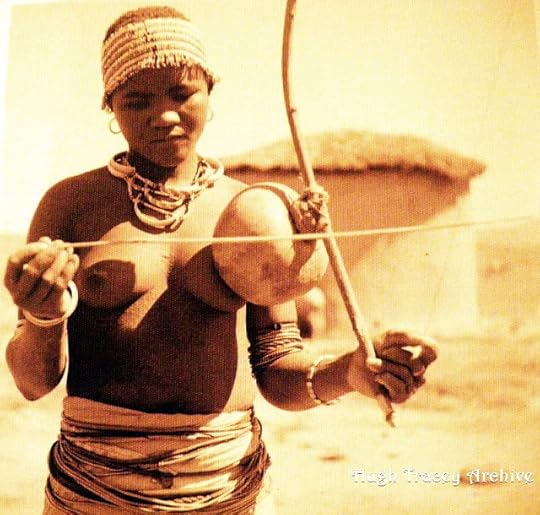
In 1958 Tracey recorded the "The Zulu Songs Princess Constance Magogo Dinuzulu"
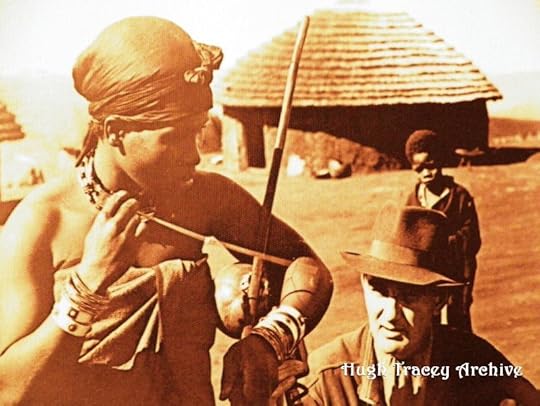
Hugh Tracey recording the "Zulu Songs Of Princess Constance Magogo Dinuzulu" with only one Nagra III tape recorder
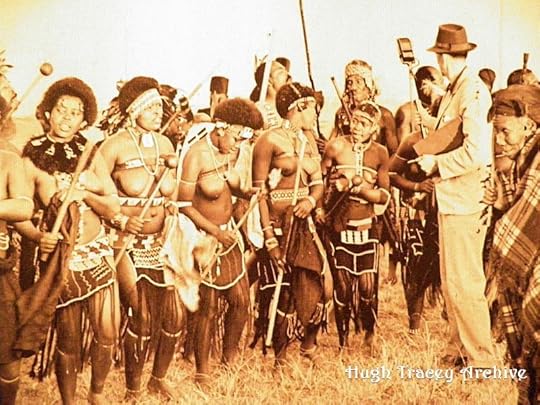
Hugh Tracey recording - as technology shrank so did his team!
Story to be continued tomorrow.
http://feeds.feedburner.com/blogspot/...
Hugh Tracey is the guardian of African music, a man who dedicated his entire life to the preservation, promotion and documentation of traditional African music for later generations. He did that at a time, when nobody else thought of it.
Hugh Tracey had such an exciting and fulfilled life, that just a couple of sentences will simply not do. To give you an idea who this man was and how he became this impressive figure known by African music lovers, we are looking at his early years from 1921 to 1947 today.

Hugh Tracey became The Guardian Of African Music. His images and his recordings of indigenous African music have been one of the first in Southern Africa
Hugh Tracey arrived in 1921 at the age of 18 in what was then called Southern Rhodesia (Zimbabwe) from Devonshire in England.
This young man had come to work on his brother's tobacco plantation in the Gutu district, near Chivu. He came like many other white people to make a living and to find a new life in colonial Africa. But soon his interest and passion in African music lead him on an entirely different path.

Hugh Tracey's Recordings Of African Music are Amongst The First That Had Been Done On The African Continent
As early as 1929 Hugh Tracey took 14 young Karanga musicians 500 km South to Johannesburg to be recorded by Columbia, London.
These are the first recordings of Karanga music ever to be published!
Soon after that several of these recordings were played as opening music at the historic first concert of African American musicians at the Carnegie Hall in NYC.
Five of the original 16 recorded items remain in the ILAM archive (International Library Of African Music) of which Hugh Tracey became later the founder.
In 1931 Hugh was awarded a Carnegie fellowship grant to study the "indigenous music of Southern Rhodesia". From 1932 to July 1933 he recorded over 600 items in the field on plain aluminium discs with an early model of reporting gear.

Hugh Tracey recording Karanga musicians in a Cape Town studio in March 1933
In 1933 he traveled by train to Cape Town with 16 Karanga musicians to take advantage of a temporary visit of a team of professional recording engineers.
In 1934/35 Hugh Tracey began a professional broad casting career at the SABC in Cape Town.
From 1936 to 1947 he was the director of the SABC radio in Durban.

Hugh Tracey is the founder of ILAM - International Library Of African Music
Hugh tracey was never too shy to use his own money for what he was passionate about.
In 1940 Hugh Tracey started out on a self funded trip to discover Chopi Timbila Xylophone orchestras in Mozambique. He was so impressed with the size of the orchestras and dance troupes and the sophistication of the music, that he brought a group of six timbila players to Durban by boat to make quality recordings of their music.
He studied thoroughly the compositional and playing techniques of Chopi music, its instrument technology and its musical form in order to write his by now famous and very much respected book "Chopi Musicians" which was published in 1948 in the Portuguese language.
Hugh was fluent in Portueguese. "Chopi Musicians" was also published in English by the Oxford Press.

A Chopi Timbila Orchestra consisting of hundreds of players in Mozambique - Image by Hugh Tracey
The field trips that Hugh Tracey conducted were rather unusual for the time.
First of all, because generally the interest in indigenous African music amongst white people in Africa specifically and in the world was very low at the beginning of the 20 th. century. Why record African music? Who would listen to it?
African indigenous music was considered as simple, repetitive and disharmonious by many at a time when Victor Silvester And His Ballroom Orchestra rocked the world with his slow fox trots and quicksteps. A distinct contrast.
Secondly these recordings were not easy to do.
Indigenous African music was played were the people lived, in the villages of Africa, on the fields and in their homes. To record their music you had to come in close contact with them and being allowed to participate in their ceremonies and their rituals. Speak their language and overcome suspicion.

"Their Words Are Never Meant For The Ears Of Outsiders", Hugh Tracey
In 1948 Hugh Tracey wrote:
"The Songs of Africa only composed for the delectation the village, the district, or at most, the tribe are a kind of aural portraiture. They reveal African thought and character more clearly than other means....for discovering what they think and feel, what they consider important in their social and political life, their humour desires, regrets and despair. They are expressed in words never meant for the ears of outsiders."
(from his book Lalela Zulu - 100 Zulu lyrics).

A Chopi Player

Hugh Tracey On A Field Trip
Hugh Tracey's team had to travel to remote areas with recording equipment, that is exhibited in museums today.

The unavoidable colonial outfit of the time

Recording equipment similar to the one Hugh Tracey used

A stop watch used in recording
Hugh Tracey's typical field expedition from 1948 onwards consisted of three vehicles: a recording van, (with EMI, Lyrec and other lathes and recorders), a truck with a 220 Volt diesel generator trailer, and a caravan.
He had a minimum crew of four or more, including a sound engineer and two driver/field assistants Sam Shabalala and Daniel Mabuto.

His typical field expedition from 1948 onwards made use of three vehicles
Recording in the field throughout the Sub-Saharan Africa wherever the music was being performed was not a simple task. Tracey had to invent a specially costumized roof raised high enough so his recording engineer could stand in the recording van, and had to have an engine strong enough to pull a generator that weighed half a ton to provide the electricity required for recording.
The noisy generator had to be set up out of ear shot; this meant a long electrical cable had to be run from the generator to the truck where the sound engineer controlled the recording equipment.
Tracey;s recording technique was to always hold the microphone in his right hand, and his stopwatch in his left hand. With the microphone on a short boom he moved around among the musicians following the sounds to capture the essence of each performance with a good sound balance and thereby produce field recordings of exceptional quality.
As technology shrank so did the team. His last recordings of Princes Constance Magogo were made with no assistance with a battery powered Nagra III tape recorder.

Hugh Tracey At Work
And in the end: he shook black people's hands - this was not done at the time.
"He was one of the few white people in Johannesburg who would shake a black man's hand as a natural thing to do". (David Coplan).

Hugh Tracey Recording
Hugh continued to research Chopi music throughout his life and career and he produced two films on timbila xylophone construction techniques Chopi Music Parts 1 and 2 in 1955.
His son Andrew followed in his footsteps and extended his own research on Chopi Music to the nyanga panpipe tradition.

Hugh Tracey had a deep passion and fascination for Chopi music and in 1948 he published his book "Chopi Musicians, Their Music, Instruments And Poetry" in Portuguese And English

He produced two films about the construction of timbila xylophone techniques Chopi Music Parts 1 and 2 in 1955

Hugh Tracey and Andrew Tracey recording Hera Mbira players in Mozambique
But Hugh Tracey did not stop there.
Although most of his research took place in Southern Africa he ventured into other African regions with his field trips as far as DRC.
In 1948 he undertook field excursion to Southern Rhodesia (Zimbabwe), Northern Rhodesia (Zambia), Northern Transvaal, Natal and South Africa.
In 1949 field excursions to Mozambique, Southern Congo, Malawi (Nyasaland) Southern Rhodesia and Northern Rhodesia were conducted by him and his team.
The images we have published here originate from some of these trip and are the property of Hugh Tracey.
They have left a deep impression on us because they show the extent and the scope of Hugh Tracey's work and the legacy he has created for his life and left behind for others with the intent to enable them to understand African music.
He was one of the first people of the last century who had a deep understanding of African music.
He understood the value of indigenous African music and it is his recordings we are collecting today and playing for you in our magazine.

Young men of the Medje Chieftancy, Mekere people playing wooden trumpets in DRC
We know about Hugh's work since a long time but when we discovered the scope and the depth of research during a visit at the small East London museum, that was hosting an exhibition about him and his life's work, we decided that we would dress this content into a story and bring it you, our readers.
Africa is the cradle of mankind and African music is world heritage.

Zulu Chief Mohlutini (Centre) leading the dance near Mahlabatini, KwaZulu Natal

Balele Pygmies playing cylindrical drums and a slit drum

Traditional Dancers In The Witwatersrand Gold Mines
In 1947 the final break through for his work came when with the support of Gallo records owner Eric Gallo he established the African Music Research Unit in Roodeport, as part of Gallo's operations. From 1947 to 1953 Gallo Records pressed several hundred 78rpm shellac records, judged at the time to be the most commercially valuable of Hugh Tracey's recordings.
In 1948 Hugh Tracey established the African Music Society Newsletter which he ran until 1953!

In 1958 Hugh Tracey recorded the famou Zulu bow player Princess Constance Magogo Dinuzulu, the mother of chief Mangosutho Buthelezi.
The 1958 recordings are found on Tracey's LP "Music of Africa" series No.37

In 1958 Tracey recorded the "The Zulu Songs Princess Constance Magogo Dinuzulu"

Hugh Tracey recording the "Zulu Songs Of Princess Constance Magogo Dinuzulu" with only one Nagra III tape recorder

Hugh Tracey recording - as technology shrank so did his team!
Story to be continued tomorrow.
http://feeds.feedburner.com/blogspot/...

Published on July 30, 2013 09:48
July 29, 2013
Junior Chamber International (JCI) Launched A Branch In Mdanstane in April 2013
The following article was written by Nkosekhaya Hlitane a 2nd year WSU journalism student. This
article looks at the formation of a branch of the Junior Chamber
International (JCI) in Mdantsane. JCI is a membership-based nonprofit organisation with branches in more than 100 countries.
Fort Hare University graduate Sophumelela Ketelo launched a local branch of the non-profit
Junior Chamber International (JCI) in Mdantsane in April.JCI is one of the biggest non-political and non-sectarian youth service organisations in the world. It has over 2000 allied branches in 115 countries.
This non-profit youth organisation aims at combating social problems such as drug abuse, school dropout rates, unemployment and poverty.
JCI plans to achieve its mission by working hand in hand with community councillors, the SAPS and the Department of Education.
“The reason I encouraged the formation of JCI in Mdantsane is because most people here live in appalling conditions. As JCI we intend to help people to make their everyday lives easier, better and more comfortable,” said Ketelo.
Ketelo added that JCI will make people’s lives easier, better and comfortable by involving the youth in the organisation and groom them to be desirable members of the community.
Ketelo joined JCI in 2009 in his first year at the University of Fort Hare’s Alice campus where he became the local secretary general.
“I believe that the youth should be the agents of change. We cannot sit back and do nothing while our community is in disarray,” said the charismatic 23-year-old leader.
Members of the public have been critical about the formation of the JCI branch.
Sonwabo Gagu, 21 from NU 6 said: “Nobody wants to board a sinking ship. The organisation does not have a unified structure working towards achieving the same goal.”
Mdumiseni Mbekwa, a resident of Slovo Park, an informal settlement in NU 6 accuses JCI of inefficiency and broken promises.
“The organisation is failing dismally to win the hearts of the people. They are dragging feet
when it comes to delivering the development programs they promised us,” he said.
Vice president Ntombi Fadi defended how the local JCI operates. “The people need to be patient with us. We do not have a spacious venue to hold meetings and that can accommodate a large group of people.” Meetings are currently held at the Ketelo house.
President Ketelo echoed Fadi’s comments saying that the organisation will be strong with time. “Rome was not built on a day. We are experiencing problems like any new organisation, we will overcome them.”
For more information on Junior Chamber International (JCI) visit www.jci.cc/guests/ and for branches in South Africa go to www.jci.cc/local/info/southafrica/chapterlocator.
http://feeds.feedburner.com/blogspot/...
article looks at the formation of a branch of the Junior Chamber
International (JCI) in Mdantsane. JCI is a membership-based nonprofit organisation with branches in more than 100 countries.
Fort Hare University graduate Sophumelela Ketelo launched a local branch of the non-profit
Junior Chamber International (JCI) in Mdantsane in April.JCI is one of the biggest non-political and non-sectarian youth service organisations in the world. It has over 2000 allied branches in 115 countries.
This non-profit youth organisation aims at combating social problems such as drug abuse, school dropout rates, unemployment and poverty.
JCI plans to achieve its mission by working hand in hand with community councillors, the SAPS and the Department of Education.
“The reason I encouraged the formation of JCI in Mdantsane is because most people here live in appalling conditions. As JCI we intend to help people to make their everyday lives easier, better and more comfortable,” said Ketelo.
Ketelo added that JCI will make people’s lives easier, better and comfortable by involving the youth in the organisation and groom them to be desirable members of the community.
Ketelo joined JCI in 2009 in his first year at the University of Fort Hare’s Alice campus where he became the local secretary general.
“I believe that the youth should be the agents of change. We cannot sit back and do nothing while our community is in disarray,” said the charismatic 23-year-old leader.
Members of the public have been critical about the formation of the JCI branch.
Sonwabo Gagu, 21 from NU 6 said: “Nobody wants to board a sinking ship. The organisation does not have a unified structure working towards achieving the same goal.”
Mdumiseni Mbekwa, a resident of Slovo Park, an informal settlement in NU 6 accuses JCI of inefficiency and broken promises.
“The organisation is failing dismally to win the hearts of the people. They are dragging feet
when it comes to delivering the development programs they promised us,” he said.
Vice president Ntombi Fadi defended how the local JCI operates. “The people need to be patient with us. We do not have a spacious venue to hold meetings and that can accommodate a large group of people.” Meetings are currently held at the Ketelo house.
President Ketelo echoed Fadi’s comments saying that the organisation will be strong with time. “Rome was not built on a day. We are experiencing problems like any new organisation, we will overcome them.”
For more information on Junior Chamber International (JCI) visit www.jci.cc/guests/ and for branches in South Africa go to www.jci.cc/local/info/southafrica/chapterlocator.
http://feeds.feedburner.com/blogspot/...

Published on July 29, 2013 00:18
July 27, 2013
The Xhosa Sacred Singers - Ndinike
Ndinike sung by the Xhosa Scared Singers was pressed in the 1940's on a silver and black 78 rpm Gallotone shellac record. Possibly the legendary Hugh Tracey has recorded this song. We do not know this for sure but the only other recording of the Xhosa Sacred Singers we could find was mentioned on "flatinternational" - The South African Audio Archive.
If you have not heard about Hugh Tracey, just keep his name in the back of your head. We are going to dedicate an article to him. Hugh Tracey, who has founded ILAM "The International Library Of African Music" situatued in Grahamstown, has had an extraordinary life and we do not know of anyone who has done more recordings of African music than him in years when African music had not yet captured the attention of other nations.
One word about our youtube channel. In short it is a channel dedicated to the music and stories of our favourite continent Africa, but not exclusively about Mdantsane.
You can find some interesting playlists like 78 rpm gramophone records, African music on vinyl and 78rpm and many more. And of course there are a lot of movies like the Mdantsane Tales and The Tales of Africa.
We will build this channel up over time and add more and more songs and movies.
Now enjoy the sound of one of the first Xhosa Choir Recordings.
http://feeds.feedburner.com/blogspot/...
If you have not heard about Hugh Tracey, just keep his name in the back of your head. We are going to dedicate an article to him. Hugh Tracey, who has founded ILAM "The International Library Of African Music" situatued in Grahamstown, has had an extraordinary life and we do not know of anyone who has done more recordings of African music than him in years when African music had not yet captured the attention of other nations.
One word about our youtube channel. In short it is a channel dedicated to the music and stories of our favourite continent Africa, but not exclusively about Mdantsane.
You can find some interesting playlists like 78 rpm gramophone records, African music on vinyl and 78rpm and many more. And of course there are a lot of movies like the Mdantsane Tales and The Tales of Africa.
We will build this channel up over time and add more and more songs and movies.
Now enjoy the sound of one of the first Xhosa Choir Recordings.
http://feeds.feedburner.com/blogspot/...

Published on July 27, 2013 09:02
July 23, 2013
Blue Seal Jive - Mafuta Amahlope
The second track on the Mafuta Amahlope 78rpm is "Blue Seal Jive".
http://feeds.feedburner.com/blogspot/...
http://feeds.feedburner.com/blogspot/...

Published on July 23, 2013 00:44
July 21, 2013
Mafuta Amahlope - The Basin Tone Drifters - Who's That Girl With The Beautiful Skin.......
Today we have a great and rare piece of music for you. And we want you to read this article first, because we are pretty sure that you will enjoy the song even more after knowing what is the story behind it.
The following article was written and researched by: The Electric Jive http://electricjive.blogspot.com/2010/07/50s-south-african-jazz-punts-skin.html.
We thank them for digging into the background of this great piece of music. Every African music lover should check out their blog.
50s South African Jazz punts skin lighteners
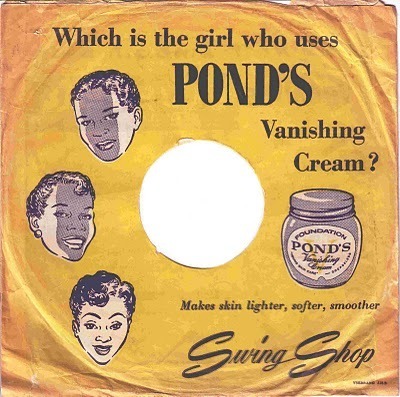
The
insidious impact of mass media in shaping our identities and preferences
goes way back and more than skin deep! Take this 78rpm South African
Jazz record from 1956, singing the praises of skin lighteners and
Vaseline. “Who’s that girl” … “the best looking girl I ever did see”
performed by the "Basin Tone Drifters" and sung in the style of the
Manhattan Brothers in English and Zulu extols the virtues of Pond’s
Vanishing Cream and Blue Seal Vaseline.
A further twist in this fascinating early advertising tale is that the
composer is registered under the pseudonym “Mafutha Amahlope” –
literally meaning “Fat Whitey”. At least the real author Christoffel
Nicolaas Du Toit had some sense of humour? The U.S. Library of Congress
Catalogue of Published Music also records that Melody Music of
Johannesburg registered these two songs on 1st October 1956.
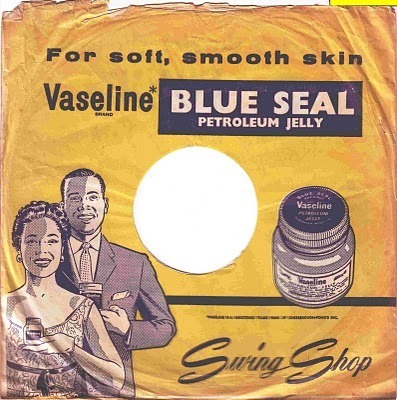
South Africa’s first commercial radio station, Springbok Radio, was
launched on 1st May 1950. African language broadcasts to the
metropolitan areas began in 1953. We wonder if these recordings were
paid-for advertising jingles or passed off as Kwela jive harmony hits?
There can be no doubt though, this record must be amongst the first
examples of purpose-made music/advertising aimed at South Africa's black
consumers.
Despite being banned in South Africa in 1986, skin lighteners are still
used, and the broader debates around skin lightening, identity, beauty
and aspirations continue. Going by a recent article in the Sowetan, these debates are changing though.
“More than ever South Africans
are realising that black is beautiful. As a nation we have overcome the
baasskap mentality that suggests that anything dark is ugly and
therefore undesirable.
“Politically we are maturing and we are taking pride in who we are.
This is filtering through to the modeling industry and the media,”
Mazibuko says.

Sudanese Supermodel Alek Wek
Mazibuko
observes that the curse of the darker skinned woman was broken by
African model Alek Wek, (right) a Sudanese refugee who made her US
modelling debut a few years ago. She has since become one of the most
sought-after models in the business.
In
addition to her magazine covers, Wek has modelled for scores of top
designers, walked in major fashion shows all over Europe and the US
opening shows for huge names such as Ralph Lauren.
Mazibuko
adds that the Africanist ideals of people such as Thabo Mbeki and
former Ghanaian president Kwame Nkrumah have influenced the way a lot of
Black South Africans think about themselves.
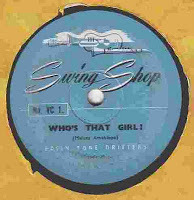
Amalope Mafuta Who's That Girl Label
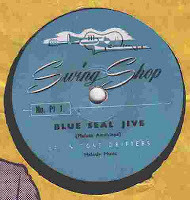
Amahlope Mafuta Blue Seal Jive Label
Now looking at 2013. Just this month Ponds has launched a new face cream called BP and the advert running every evening a dozen times on TV goes like this; " I want radiant and flawless skin in an instant"......., said by a stunning beautiful girl of very light skin tone.....
http://feeds.feedburner.com/blogspot/...
The following article was written and researched by: The Electric Jive http://electricjive.blogspot.com/2010/07/50s-south-african-jazz-punts-skin.html.
We thank them for digging into the background of this great piece of music. Every African music lover should check out their blog.
50s South African Jazz punts skin lighteners

The
insidious impact of mass media in shaping our identities and preferences
goes way back and more than skin deep! Take this 78rpm South African
Jazz record from 1956, singing the praises of skin lighteners and
Vaseline. “Who’s that girl” … “the best looking girl I ever did see”
performed by the "Basin Tone Drifters" and sung in the style of the
Manhattan Brothers in English and Zulu extols the virtues of Pond’s
Vanishing Cream and Blue Seal Vaseline.
A further twist in this fascinating early advertising tale is that the
composer is registered under the pseudonym “Mafutha Amahlope” –
literally meaning “Fat Whitey”. At least the real author Christoffel
Nicolaas Du Toit had some sense of humour? The U.S. Library of Congress
Catalogue of Published Music also records that Melody Music of
Johannesburg registered these two songs on 1st October 1956.

South Africa’s first commercial radio station, Springbok Radio, was
launched on 1st May 1950. African language broadcasts to the
metropolitan areas began in 1953. We wonder if these recordings were
paid-for advertising jingles or passed off as Kwela jive harmony hits?
There can be no doubt though, this record must be amongst the first
examples of purpose-made music/advertising aimed at South Africa's black
consumers.
Despite being banned in South Africa in 1986, skin lighteners are still
used, and the broader debates around skin lightening, identity, beauty
and aspirations continue. Going by a recent article in the Sowetan, these debates are changing though.
“More than ever South Africans
are realising that black is beautiful. As a nation we have overcome the
baasskap mentality that suggests that anything dark is ugly and
therefore undesirable.
“Politically we are maturing and we are taking pride in who we are.
This is filtering through to the modeling industry and the media,”
Mazibuko says.

Sudanese Supermodel Alek Wek
Mazibuko
observes that the curse of the darker skinned woman was broken by
African model Alek Wek, (right) a Sudanese refugee who made her US
modelling debut a few years ago. She has since become one of the most
sought-after models in the business.
In
addition to her magazine covers, Wek has modelled for scores of top
designers, walked in major fashion shows all over Europe and the US
opening shows for huge names such as Ralph Lauren.
Mazibuko
adds that the Africanist ideals of people such as Thabo Mbeki and
former Ghanaian president Kwame Nkrumah have influenced the way a lot of
Black South Africans think about themselves.

Amalope Mafuta Who's That Girl Label

Amahlope Mafuta Blue Seal Jive Label
Now looking at 2013. Just this month Ponds has launched a new face cream called BP and the advert running every evening a dozen times on TV goes like this; " I want radiant and flawless skin in an instant"......., said by a stunning beautiful girl of very light skin tone.....
http://feeds.feedburner.com/blogspot/...

Published on July 21, 2013 11:50
July 15, 2013
Ironside And His Sister - A Very Old Xhosa Fairy Tale - A Short Movie
This Chocolat Negro short movie
narrates a very old Xhosa Fairy Tale in a modern way and tries to demonstrate the beauty
of the original old Xhosa culture of the Eastern Cape.
It has been
conceptualized as a mixed-media project, not only telling the story but
underlining it with visuals.
Historical images and installations, as
well as modern digital photography have been used. Seven of the images in the story come from the work of photographer Alice Mertens.
The "Xhosa-life-behind-glass-displays" in the East London Museum have been photographed and digitally altered to create real life impressions for the movie.
The story of "Ironside And His Sister" has been
first written down in 1886 by Georg McCall Theal and was published as part of his book "Kaffir Folk-Lore - A Selection from the Traditional Tales Current Among the People Living on the Eastern Border of the Cape Colony - with copious explanatory notes, London: S. Sonnenschein, Le Bas & Lowrey".
In 1886 the author explained in his book that "in South Africa the word kaffir is often used in a general way to describe any black native who is not the descendant of an imported slave, but on the Eastern Frontier of the Cape Colony it usually restricted to a member of the Amaxhosa tribe. It is from individuals of this tribe that the following stories have been collected".
George McCall Theal (11 April 1837 - 17 April 1919),
was the most prolific and influential South African historian,
archivist and genealogist of the late nineteenth and early twentieth
century.
Many antique books of the nineteenth century dealing with African folklore (Folk Tales) are impossible to get and extremely expensive. There are few. Although McCall Theal lived in the colonial era his collection of Xhosa Fairy Tales is one of the few attempts to record and write down the traditional folk stories and legends of the people of the Eastern Cape for later generations in that time.
"Ironside And His Sister" is the first movie of a series of stories we have filmed and brought to life in an attempt to bring these great stories to a greater public who might not even be aware of them.
In the movie we are
taking the listener and viewer on an uninterrupted journey forth and
back between the past and the today of the Eastern Cape.
For the readers who have read with great excitement the articles about the "Traditional Way Of Dressing In the Xhosa Culture" this might be an interesting movie. The historical images show how the Xhosa people dressed before the influence of colonialism and Western Cultures.
http://feeds.feedburner.com/blogspot/...
narrates a very old Xhosa Fairy Tale in a modern way and tries to demonstrate the beauty
of the original old Xhosa culture of the Eastern Cape.
It has been
conceptualized as a mixed-media project, not only telling the story but
underlining it with visuals.
Historical images and installations, as
well as modern digital photography have been used. Seven of the images in the story come from the work of photographer Alice Mertens.
The "Xhosa-life-behind-glass-displays" in the East London Museum have been photographed and digitally altered to create real life impressions for the movie.
The story of "Ironside And His Sister" has been
first written down in 1886 by Georg McCall Theal and was published as part of his book "Kaffir Folk-Lore - A Selection from the Traditional Tales Current Among the People Living on the Eastern Border of the Cape Colony - with copious explanatory notes, London: S. Sonnenschein, Le Bas & Lowrey".
In 1886 the author explained in his book that "in South Africa the word kaffir is often used in a general way to describe any black native who is not the descendant of an imported slave, but on the Eastern Frontier of the Cape Colony it usually restricted to a member of the Amaxhosa tribe. It is from individuals of this tribe that the following stories have been collected".
George McCall Theal (11 April 1837 - 17 April 1919),
was the most prolific and influential South African historian,
archivist and genealogist of the late nineteenth and early twentieth
century.
Many antique books of the nineteenth century dealing with African folklore (Folk Tales) are impossible to get and extremely expensive. There are few. Although McCall Theal lived in the colonial era his collection of Xhosa Fairy Tales is one of the few attempts to record and write down the traditional folk stories and legends of the people of the Eastern Cape for later generations in that time.
"Ironside And His Sister" is the first movie of a series of stories we have filmed and brought to life in an attempt to bring these great stories to a greater public who might not even be aware of them.
In the movie we are
taking the listener and viewer on an uninterrupted journey forth and
back between the past and the today of the Eastern Cape.
For the readers who have read with great excitement the articles about the "Traditional Way Of Dressing In the Xhosa Culture" this might be an interesting movie. The historical images show how the Xhosa people dressed before the influence of colonialism and Western Cultures.
http://feeds.feedburner.com/blogspot/...

Published on July 15, 2013 00:26
July 10, 2013
The Mdantsane Youth Gets Involved In A Coastal Clean Up
Sometimes cleaning up somebody else's mess can be fun. Hard to believe? It is!
But looking at these pictures there is no doubt, that the students from a Mdantsane High School in NU 6 did enjoy their day greatly, so that even the task of picking up waste along East London's beach front generally called the Esplanade became a ride in a park. It's all about company!

Mdantsane High School Learners Are Participating In A Coastal Clean Up Day
At the end of last year the environmental youth club of the Inkwenkwesi High School in Mdantsane participated in a voluntary coastal clean-up day. They made the journey from Mdantsane to East London's beach front via bus to help picking up waste and cleaning the rocks and the beach from the thrash, that has been dropped there by the East London citizens.
Littering has meanwhile become one of the biggest problems East London and its environment are facing. The streets of East London, including all suburbs, the townships Mdanstane and Duncan Village and the pristine beaches are showered with empty cans, plastic containers, paper etc.
We really mean it!
Hey come on, you might say now, "showered" is that not a drastic exaggeration? Sure you might find the occasional piece of glass or plastic but do you really mean showered?
Yes we do. If we take you on a beach walk, we will find (without making an effort) at least a dozen items, that can be considered trash without any doubt! If we take you on the same beach walk tomorrow, we will find ten more items. And we can repeat that day after day and the result will always be the same.
The importance of environmental education classes in schools and creches can not be overstressed. Theoretically environmental education should be taught at an early age but practically it does not happen in South African schools. This means there is hardly any consideration amongst the youth for the environment.
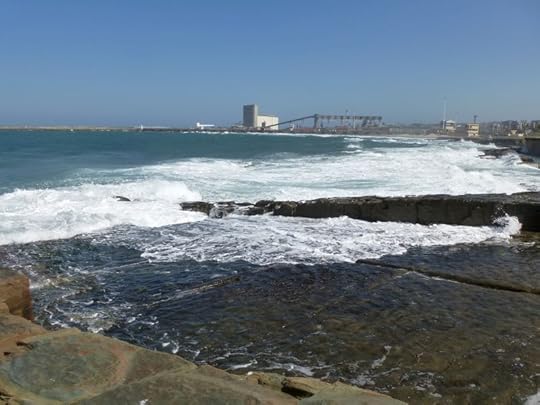
The Entry to the East London River Port - The One And Only River Port in South Africa
But East London's harbour and its coastline are indeed very special. East London lies on the Indian Ocean coast, between the Buffalo River and the Nahoon River and hosts South Africa's only river port.
A little bit of history for the ones who are interested (you others just look at the pictures meanwhile): Lieutenant John Bailie of the Royal Navy, one of the 1820 Settlers, surveyed the Buffalo River mouth and founded the town in 1836, with a memorial on Signal Hill commemorating the event.
The city formed around the only river port in South Africa and was
originally known as Port Rex. This settlement on the West Bank was the
nucleus of the town of East London, which was elevated to city status in
1914.
During the early to mid-19th century frontier wars between the British settlers and the local Xhosa inhabitants, East London served as a supply port to service the military headquarters at nearby King William’s Town, about thirty miles away. A British fort, Fort Glamorgan, was built on the West Bank in 1847, and annexed to the Cape Colony that same year.
This fort is one of a series of forts the British built, that include Fort Murray, Fort White, Fort Cox Fort Hare and Fort Beaufort, in the border area that became known as British Kaffraria.
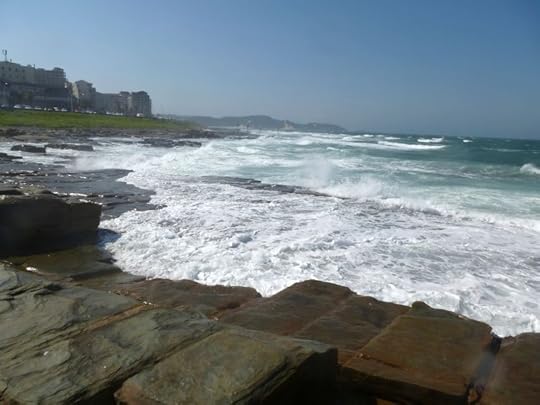
Some Of East London's Conference Centers And Hotels Can Be Seen in The Back
With later development of the port came the settlement of permanent
residents, including German settlers, most of whom were bachelors. These
settlers were responsible for German names of some towns in the
vicinity of East London such as Stutterheim and Berlin.
Today, German surnames such as Gehring, Salzwedel and Peinke are still
common in East London, but the descendants of the settlers rapidly
became anglicised.
The existing port, in the mouth of the Buffalo River, adjoining the Indian Ocean, began operating in 1870.
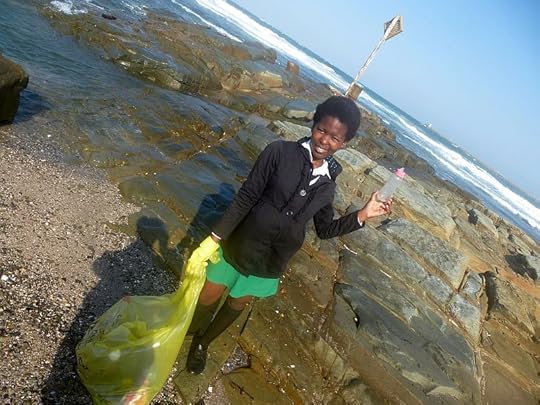
Bags And Bags of Waste Are Picked Up By The Students In Only A Couple Of Hours
East London is today the host city of a large Mercedes Benz assembly line. Thousands of cars are produced in this city and are shipped with gigantic container ships to international destinations.
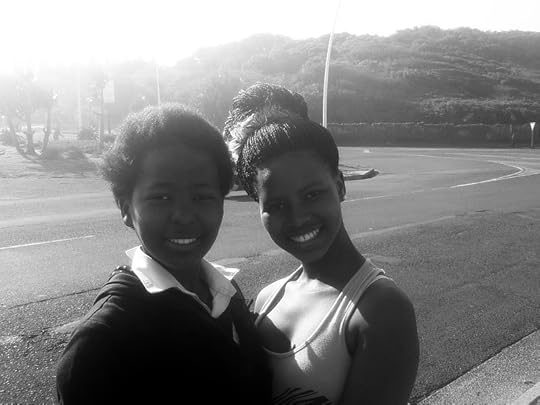
While some enjoyed the windy but beautiful day

Others Made Contact With The Ice Cold Waters Of The Eastern Cape
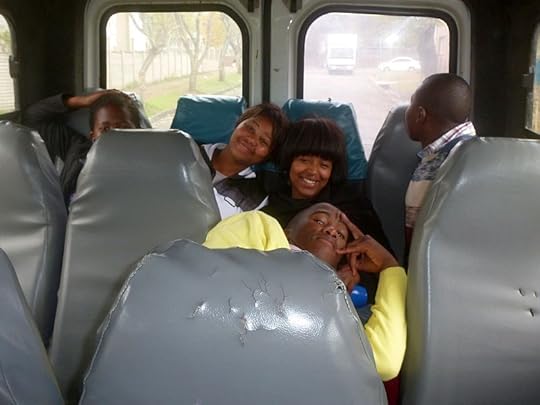
The Ride In The Bus To The Beach And Back To Mdantsane Was Of Course Something Else

At least one of the two is a little bit intimidated by the breaking waves
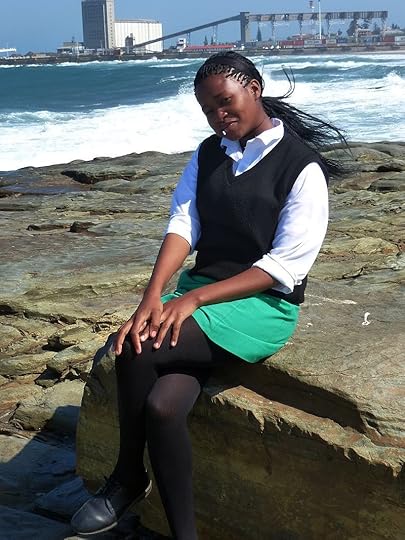
Others in Safe Distance Were Dedicating Time To The Art Of Best Presenting Oneself To The Rest Of The World
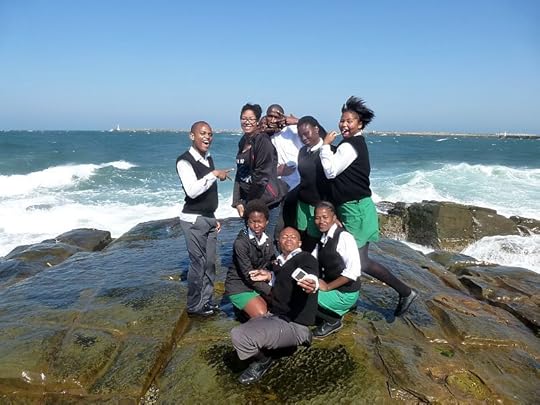
And A Picture To Remember This Day
There is no better feeling in the whole world, than to know somebody has really done something good and has contributed to make the world a little bit a better place.
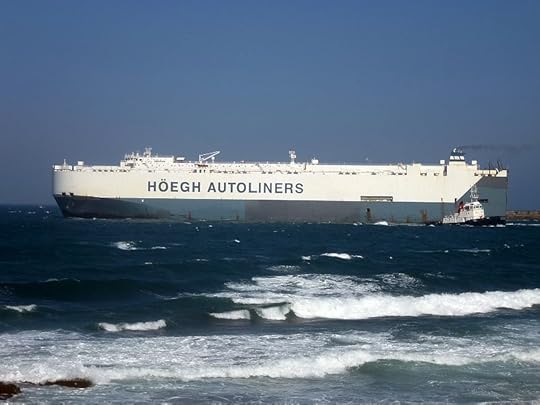
A Hoegh Autoliner Container Ship carries a precious and very expensive load of Mercedes Benz luxury cars
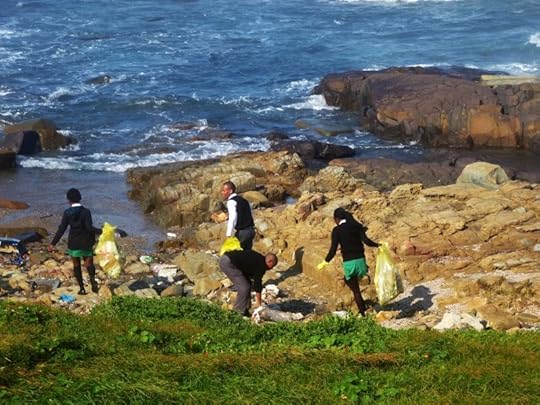
The Waste Does Not Seem To End
And what you learn young you never forget!

Slippery When Wet
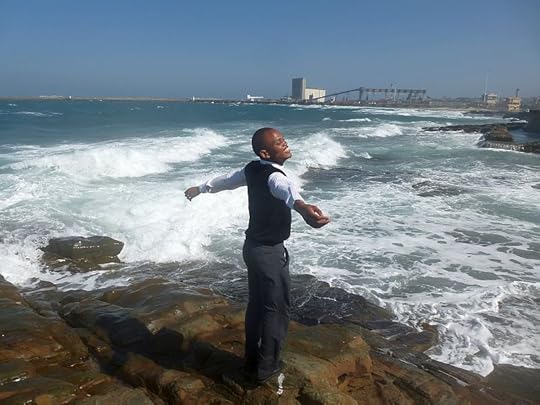
A Feeling Of Freedom
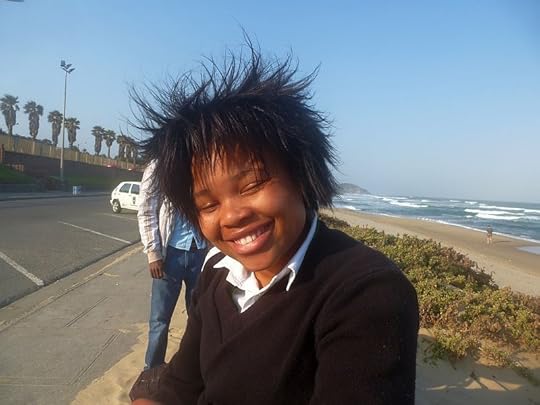
Beauty Made In South Africa
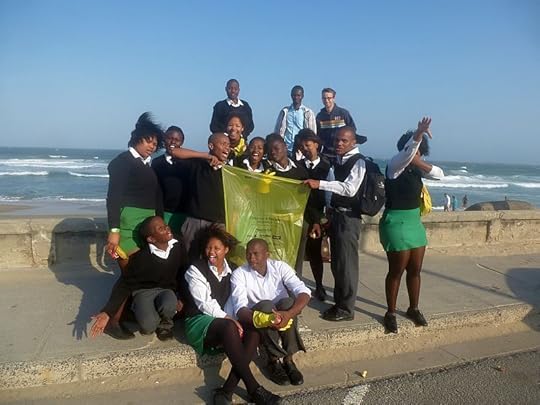
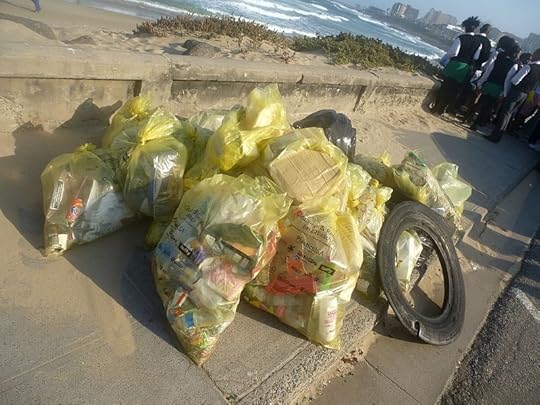
Just one afternoon's waste collection by a couple of young people
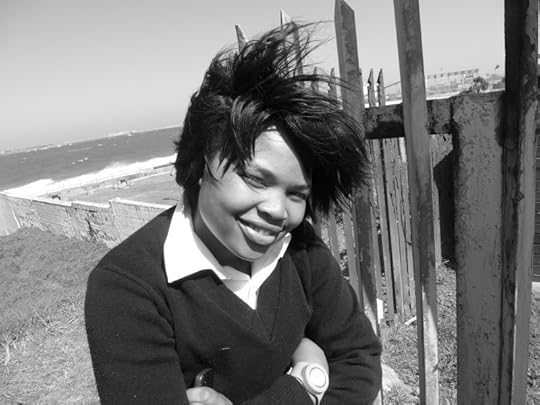

For the future to look bright it needs to be clean
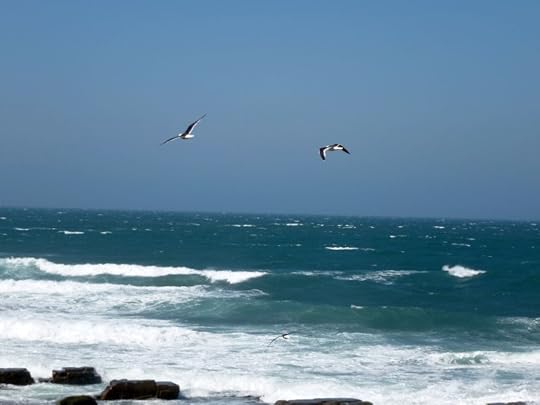
The Sky Is The Limit
And for the vendors from Kenya, Zimbabwe, Congo and Ghana it was business as usual at the Esplanade!
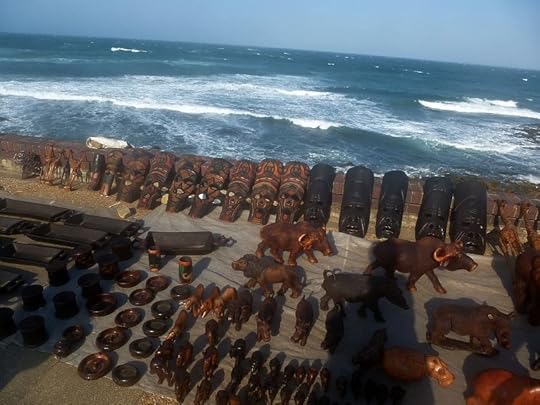
http://feeds.feedburner.com/blogspot/...
But looking at these pictures there is no doubt, that the students from a Mdantsane High School in NU 6 did enjoy their day greatly, so that even the task of picking up waste along East London's beach front generally called the Esplanade became a ride in a park. It's all about company!

Mdantsane High School Learners Are Participating In A Coastal Clean Up Day
At the end of last year the environmental youth club of the Inkwenkwesi High School in Mdantsane participated in a voluntary coastal clean-up day. They made the journey from Mdantsane to East London's beach front via bus to help picking up waste and cleaning the rocks and the beach from the thrash, that has been dropped there by the East London citizens.
Littering has meanwhile become one of the biggest problems East London and its environment are facing. The streets of East London, including all suburbs, the townships Mdanstane and Duncan Village and the pristine beaches are showered with empty cans, plastic containers, paper etc.
We really mean it!
Hey come on, you might say now, "showered" is that not a drastic exaggeration? Sure you might find the occasional piece of glass or plastic but do you really mean showered?
Yes we do. If we take you on a beach walk, we will find (without making an effort) at least a dozen items, that can be considered trash without any doubt! If we take you on the same beach walk tomorrow, we will find ten more items. And we can repeat that day after day and the result will always be the same.
The importance of environmental education classes in schools and creches can not be overstressed. Theoretically environmental education should be taught at an early age but practically it does not happen in South African schools. This means there is hardly any consideration amongst the youth for the environment.

The Entry to the East London River Port - The One And Only River Port in South Africa
But East London's harbour and its coastline are indeed very special. East London lies on the Indian Ocean coast, between the Buffalo River and the Nahoon River and hosts South Africa's only river port.
A little bit of history for the ones who are interested (you others just look at the pictures meanwhile): Lieutenant John Bailie of the Royal Navy, one of the 1820 Settlers, surveyed the Buffalo River mouth and founded the town in 1836, with a memorial on Signal Hill commemorating the event.
The city formed around the only river port in South Africa and was
originally known as Port Rex. This settlement on the West Bank was the
nucleus of the town of East London, which was elevated to city status in
1914.
During the early to mid-19th century frontier wars between the British settlers and the local Xhosa inhabitants, East London served as a supply port to service the military headquarters at nearby King William’s Town, about thirty miles away. A British fort, Fort Glamorgan, was built on the West Bank in 1847, and annexed to the Cape Colony that same year.
This fort is one of a series of forts the British built, that include Fort Murray, Fort White, Fort Cox Fort Hare and Fort Beaufort, in the border area that became known as British Kaffraria.

Some Of East London's Conference Centers And Hotels Can Be Seen in The Back
With later development of the port came the settlement of permanent
residents, including German settlers, most of whom were bachelors. These
settlers were responsible for German names of some towns in the
vicinity of East London such as Stutterheim and Berlin.
Today, German surnames such as Gehring, Salzwedel and Peinke are still
common in East London, but the descendants of the settlers rapidly
became anglicised.
The existing port, in the mouth of the Buffalo River, adjoining the Indian Ocean, began operating in 1870.

Bags And Bags of Waste Are Picked Up By The Students In Only A Couple Of Hours
East London is today the host city of a large Mercedes Benz assembly line. Thousands of cars are produced in this city and are shipped with gigantic container ships to international destinations.

While some enjoyed the windy but beautiful day

Others Made Contact With The Ice Cold Waters Of The Eastern Cape

The Ride In The Bus To The Beach And Back To Mdantsane Was Of Course Something Else

At least one of the two is a little bit intimidated by the breaking waves

Others in Safe Distance Were Dedicating Time To The Art Of Best Presenting Oneself To The Rest Of The World

And A Picture To Remember This Day
There is no better feeling in the whole world, than to know somebody has really done something good and has contributed to make the world a little bit a better place.

A Hoegh Autoliner Container Ship carries a precious and very expensive load of Mercedes Benz luxury cars

The Waste Does Not Seem To End
And what you learn young you never forget!

Slippery When Wet

A Feeling Of Freedom

Beauty Made In South Africa


Just one afternoon's waste collection by a couple of young people


For the future to look bright it needs to be clean

The Sky Is The Limit
And for the vendors from Kenya, Zimbabwe, Congo and Ghana it was business as usual at the Esplanade!

http://feeds.feedburner.com/blogspot/...

Published on July 10, 2013 09:55



